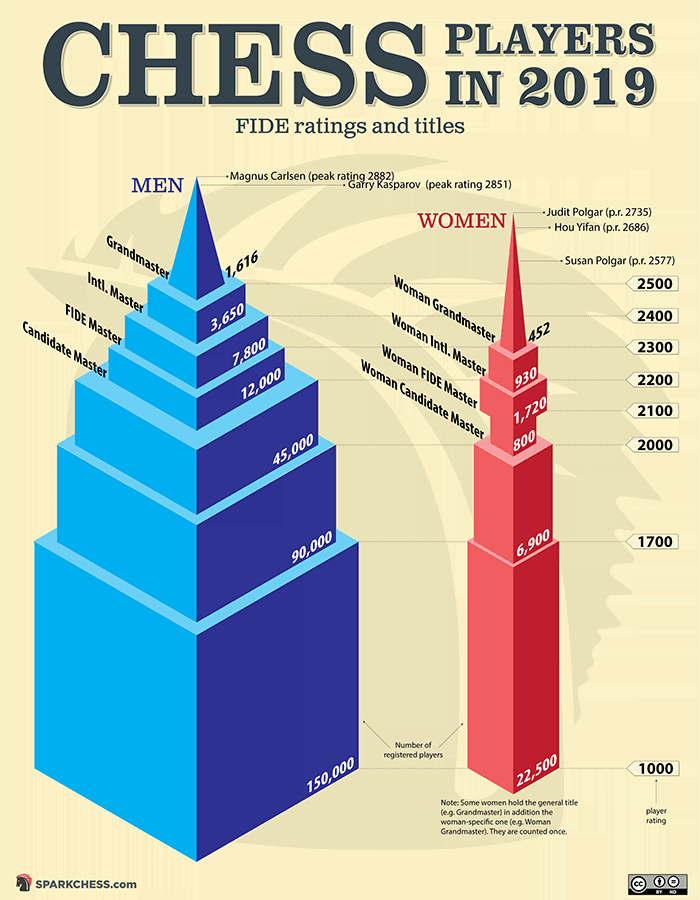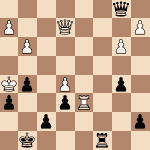Have you ever wondered just how many chess players are in the world? How many of them are women? And what’s with all the titles like chess master and international master? Who is the top chess player ever?
The answers to all these questions are in the infographic below:

This infographic is released under a Creative Commons License / BY-ND, which means please feel free to redistribute it as long as you link back to sparkchess.com and you don’t alter it. You can download a high-res, print ready PDF version:
What are the chess titles?
While we can’t know for sure just how many chess players are in the world, we know how many registered chess players there are with FIDE. FIDE stands for Fédération Internationale des Échecs or the World Chess Federation.
FIDE uses these titles:
- Candidate Master
- FIDE Master
- International Master
- Grandmaster
National Master is not a FIDE title, so it’s not included here.
Titles are awarded to players based on complex rules, but the most important is their rating. A 2200 rating is required for a Candidate Master, 2300 for FIDE Master and so on. Titles are for life.
There are separate titles for women – Woman Candidate Master, Woman FIDE Master, Woman International Master and Woman Grandmaster. The rating requirement for each title is 200 points lower than than the general counterpart. Some women hold the general title as well – and in some cases both!
How the rating is calculated
All chess players have a “rating,” also known as Elo rating, from Arpad Elo, the Hungarian inventor of the rating system.
The rating is an indicator of skill. When a rated chess player beats another one, they take some points from the losing one. The difference between their rating determines how many points are awarded. A higher-rated player who defeats a lower-rated one will be awarded only a few points. However, if the lower-rated player defeats the higher-rated one, they’ll be awarded much more.
Given enough games, the system allows the good players to rank higher.

lku
If this is supposed to show stats on all players then why aren’t uscf players displayed?
This shows only FIDE (World Chess Federation) info, not the US Chess Federation info.
The ratings are calculated slightly different, they are not exactly equivalent.
Very interesting !
Do you have similar material for the age pyramid (distribution of players according to their age).
My assumption is that chess is widely practiced by players in the 45-75 years, average by young players (8-18), but significantly less for the players in the 18-45 range.
And the important factor linked to this is the practice on Internet chess vs physical club chess (the pyramid is extremely different for those categories).
Assumption based on European (Belgian) context.
Any material welcome !!!
While acquiring rating and getting norms have been the traditional way of gaining titles, players may also get titles from competing in International youth events, prestigious tournaments like interzonals (qualifiying tournaments to the world cup) and of course scoring a certain amount of points in the Chess Olympiad.
It used to be that all a player had to do was score a certain amount of points to win thus it was not unusual to see teenagers or even kids acquire Candidate Master or even FIDE Master titles from winning youth events while having a rating that is far below the requirement. These events were originally organised to promote and encourage players who otherwise would have to fly out in far off places to compete.
Recently however FIDE put in place that players had to achieve a minimum rating as I understand it 200 points below their actual requirement as well as scoring a certain amount of points in a prestigious event. For e.g FM could be gained by someone who reached 2100 FIDE and scored 6/9 in an interzonal event. While IM could be gained by winning the event (or coming =1st) and holding a rating of at least 2200 at one point in their lives. These additonal rating reuirements was used so to prevent the rapid influx of titled players that occured during every interzonal event. Ironically these events were created with the intention of giving every FIDE zone a chance at qualifying for the world championships via the World cup.
To my mind GM titles may be earned from the Winner of the Senior World Championships as well as the semi finals to the World Cup. Olympiad level events may also count as double norm events. (Thus if you score a GM norm in an olympiad it counts as 2 norms not one, presumably because the level of pay at the Olympiad is so much higher).
So there you have it multiple ways of gaining titles whether it be through the hard work of rating or the participation and placing of high level tournaments. Of course having a title doesn’t nescessarily make you strong and being strong doesn’t mean you have to have a title. So I guess the only thing you should be focused on is making good moves!